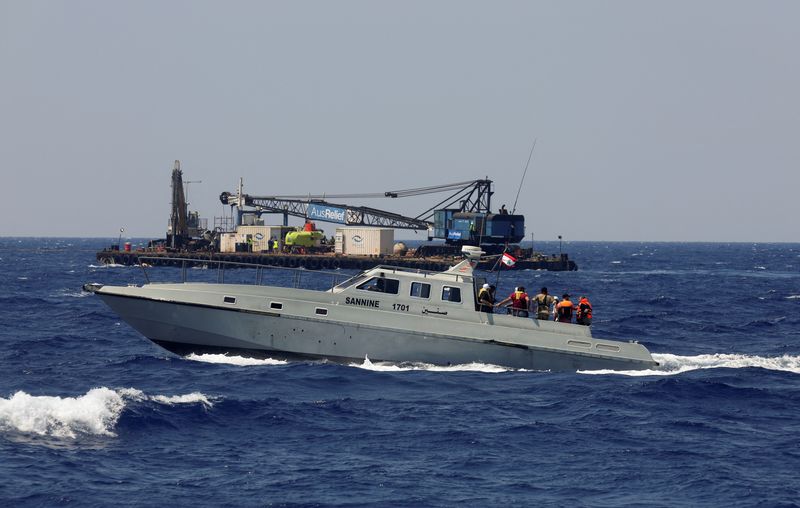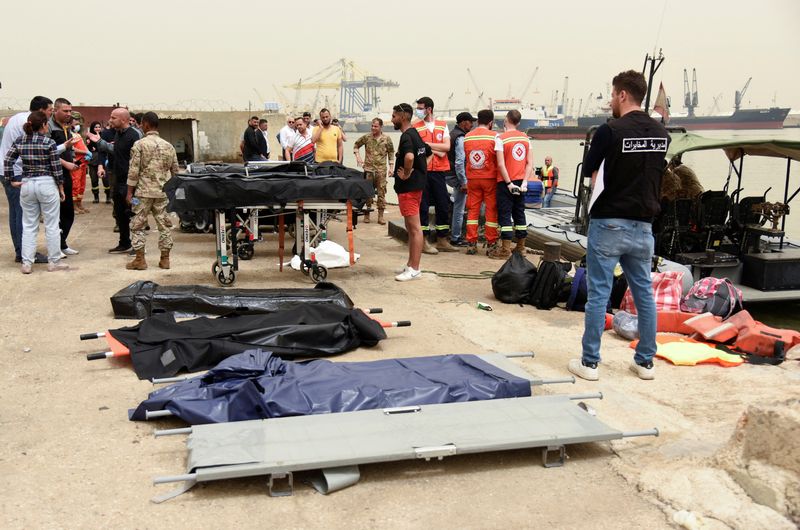By Timour Azhari
TRIPOLI, Lebanon (Reuters) - On the still blue bottom of the Mediterranean Sea off the coast of north Lebanon, the crew of the specialised exploration submarine Pisces VI found their first corpse.
Captain Scott Waters (NYSE:WAT), leading the small yellow submarine's quest to unravel the fate of migrants missing since their boat sank on April 23, said the crew decided to bring the badly decomposed remains to the surface half a kilometre above.
But as it was hoisted to the surface, the body disintegrated piece by piece, scattering like sand in the water, leaving only clothes in the grip of the submarine's robotic arm.
The research submarine arrived last week on a mission by Australia-based NGO AusRelief to bring answers to the families of dozens of people still missing and presumed dead - answers the dysfunctional, cash-strapped Lebanese state has yet to provide.
The Pisces VI located the boat, which Waters said showed no clear signs of damage from a navy boat that intercepted it, as well as 10 bodies. But the mission has since ended after the Lebanese military informed AusRelief of possible security risks, mission chief Tom Zreika told Reuters.
Zreika, a former refugee who was himself taken by his mother on a similar journey to Cyprus at the outset of Lebanon's civil war in 1975, said AusRelief regrettably concluded that salvaging all the bodies and the boat would entail much greater resources.
"There was a woman down there stuck halfway out a window holding her baby...That's the one that broke everybody's (heart)," he said, referring to the mission team. "It reminded me how my mother would have been holding me."
The dinghy was designed to carry up to a dozen people. About 80 Lebanese, Syrian and Palestinian migrants were on board, of which some 40 were rescued, seven were confirmed dead and around 30 remain missing.
Distraught families of the missing hoped the submarine would reveal the fate of their loved ones and how the boat came to sink. They now fear the bodies will remain submerged for good, along with potential evidence.
Although an investigation by Lebanese authorities into the incident is still ongoing, few families expect it to come to a just conclusion, underlining deep popular mistrust in Lebanon's judiciary and state institutions.
Locals say worsening economic desperation and hopelessness in the impoverished area of north Lebanon from which the migrant boat departed will spur ever more people to embark on perilous journeys by sea in search of new lives in Europe.
'I'M READY TO GO'
The number of people who left or tried to leave Lebanon by sea nearly doubled in 2021 from 2020, and has risen again by more than 70% in 2022 compared with the same period last year, the United Nations refugee agency told Reuters in an email.
The main reasons cited include an "inability to survive in Lebanon due to the deteriorating economic situation" and the "lack of access to basic services and limited job opportunities", it said.
Lebanon has been grappling with a severe financial crisis since 2019 that has left eight in 10 people poor.
The migrant boat capsized and sank after a collision with a Lebanese navy ship trying to halt its voyage towards Europe.
Authorities believe it left from the sleepy seaside town of Qalamoun just south of the major port of Tripoli, from the quay of an abandoned resort where locals go to spend leisure time.
"All we want to do is leave this country. There is nothing here anymore," said Bilal Hamam, a 42-year-old day labourer at a local cement factory who was not called to work on Monday.
"My friends have gone (on previous migrant boats). I was scared to go because I have kids...but now I'm ready to go with my family," he said.
"I'm no better than those who died and nor are my children."
'A MOCKERY'
Some families of the victims have filed criminal charges against the navy officer commanding the ship that intercepted the migrant boat and the dozen other crew aboard, after some surviving migrants said they had been rammed.
The army has said its ship and the boat collided as the people smuggler in charge manoeuvred to evade capture.
The investigation has been led by Lebanon's Military Court, staffed by army personnel.
"It's a mockery in every sense of the word...that any self-respecting institution would be the perpetrator accused of killing people and also oversee the probe," said Jihad Medlej, the father of 22-year-old Hashem Medlej who was on the boat and remains missing.
"We will not be silent about this...We want to live in a state with institutions and laws," Mohammad Sablouh, a lawyer representing some families, told Reuters.
A spokesman for the army told Reuters that it could not comment on the complaints and accusations by relatives of the dead due to the ongoing investigation.
In a meeting in May with grieving families of the victims, General Joseph Aoun, Lebanon's armed forces commander in chief, promised a transparent and impartial inquiry.
But Medlej, rejecting the army narrative, said he has not been able to mourn his son because he has received contradictory reports about his fate, with no body recovered, and believes he may still be alive.
An army source, asking for anonymity due to the ongoing investigation, said it had no information on Hashem Medlej.
An attempt by a lawyer for the families to subpoena Waters to provide more information in court on the submarine mission's findings, including high-definition footage, failed because Lebanon's judiciary was on strike.
The captain has since left Lebanon, and the army has so far only published low-quality images of the wreck.
Zreika said he would soon make all the footage public.
He lamented the growing bad blood between ordinary people and institutions in Lebanon.

Before departing, the mission team held a small service at sea for those who perished, but the army advised them against bringing relatives of victims along, Zreika said.
"They said: 'We can't guarantee your safety.'"
